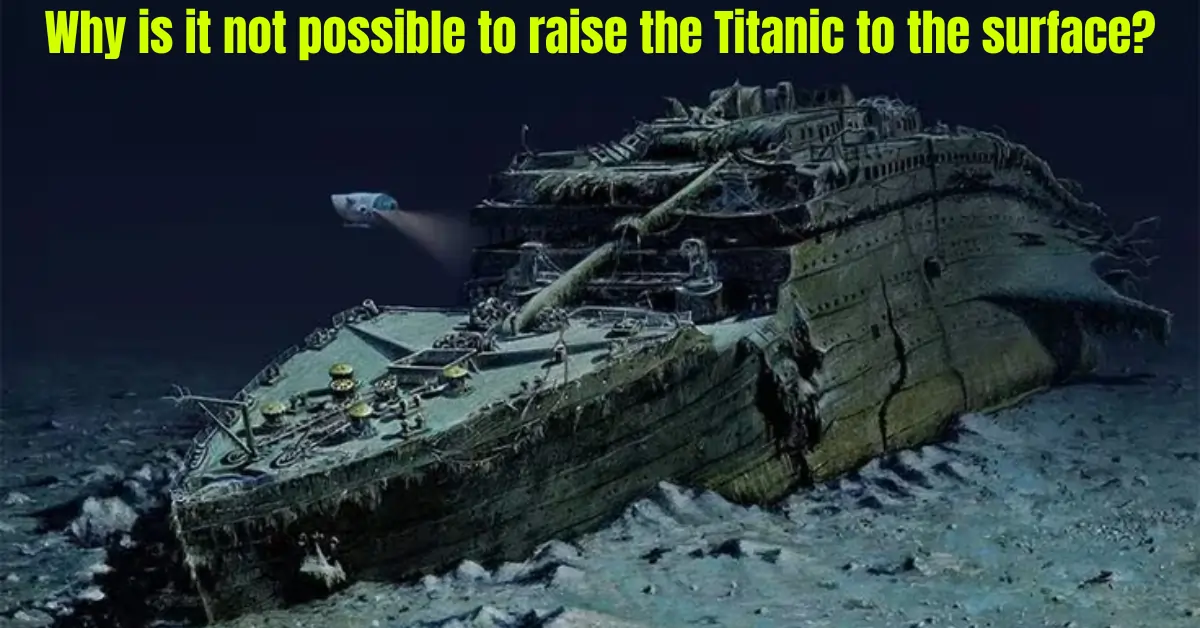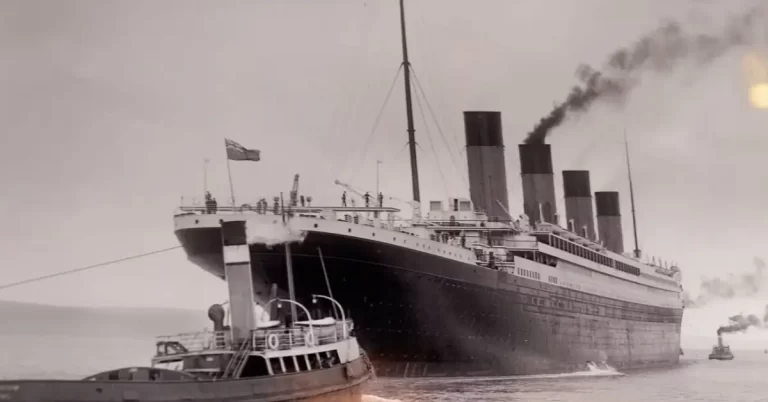Why is it impossible for the Titanic to resurface?
The Titanic went down in 1912, and it wasn’t until more than seven decades later that its wreckage was finally discovered. It will remain in its current resting place until the ship gradually deteriorates and disappears.
Titanic's Inaugural Atlantic Voyage in April 1912
In April 1912, the Titanic embarked on its inaugural journey across the vast Atlantic Ocean. This remarkable vessel, once proudly acclaimed as “unsinkable,” departed from Southampton with its destination set for New York City. Tragically, the Titanic’s fate took a dire turn when it collided with an iceberg, tearing open its hull. In a mere two hours and forty minutes, this colossal ship succumbed to the depths of the ocean, claiming the lives of over 1,500 passengers.
It would take over seven decades to locate the wreckage of the ill-fated ship but attempts to locate and raise the Titanic began almost as soon as it had sunk. However, even those ideas to recover the remains of the sunken ship that weren’t totally bonkers ran into other problems.
Challenges in Raising the Titanic from the Ocean Floor
Despite the advancements in technology, there are still many challenges associated with raising from the ocean floor. These challenges include:
Immense Depth: The Titanic rests at a depth of around 12,500 feet (3,800 meters) below the ocean’s surface, which creates immense pressure and poses significant technical difficulties for any salvage operation.
Structural Fragility: Over the past century, the ship has deteriorated significantly due to corrosion and the effects of deep-sea pressure. The ship’s hull is now fragile and prone to further damage, making it difficult to lift it without causing it to break apart.
High Costs: The cost of raising the ship is estimated to be astronomical, running into billions of dollars. The complexity of the operation, the depth of the wreck, and the need for specialized equipment and personnel all contribute to the high cost.
Ethical Considerations: The Titanic is considered a gravesite for the over 1,500 passengers and crew who perished in its sinking. Raising the ship would disturb the final resting place of these individuals and could raise ethical concerns.
Legal Complexities: The ownership of the Titanic is a complex legal issue, with multiple parties claiming rights to the wreck. Resolving these legal issues would be a prerequisite for any salvage operation.
Given these challenges, it is unlikely that the ship will ever be raised from the ocean floor. The ship’s deep-sea resting place, fragile state, and the associated costs, ethical considerations, and legal complexities make such an undertaking impractical
Why can’t the remains of the Titanic be resurfaced?
One of the primary factors is the Titanic’s location, resting approximately 12,500 feet beneath the surface of the North Atlantic. This environment presents significant challenges for operations both above and below the water. The combination of these challenging conditions and the immense size of the ship makes any retrieval project prohibitively expensive, which has deterred previous attempts.
It has now become evident that the Titanic will remain in its current resting place, at least for the time being, as it is too delicate to be raised from the ocean floor. The corrosive nature of the salt water, along with the presence of an iron-consuming bacterium, is gradually deteriorating the hull of the ship. This bacterium seems to be growing more aggressive and will ultimately reduce the Titanic to a collection of rusticle fragments. Additionally, it is crucial to remember that the site is technically a resting place for the more than 1,500 souls who lost their lives.
What methods have been proposed to raise the Titanic?
Numerous items have been salvaged from the wreckage of the Titanic, including a sizable 15-ton section of the hull colloquially referred to as the “Big Piece,” which was recovered in 1998. Although plans to bring the two main sections to the surface have been abandoned, there have been intriguing proposals for achieving this feat.
One such plausible idea involved using balloons that would be inflated beneath the wreckage to elevate the Titanic to the surface. This concept was vividly depicted in the 1980 film ‘Raise the Titanic,’ which was based on a book of the same title, showcasing the successful execution of the endeavor.
In addition to the current fragility of the hull, such an undertaking would have necessitated meticulous coordination to ensure that the balloons were inflated at the correct rate, allowing the hull to ascend at a controlled speed and avoiding disintegration. Furthermore, it would have demanded a substantial amount of helium.
One of the earliest concepts, proposed in 1914, suggested employing electromagnets to engage with the remains and draw them to the surface. In the 1960s and 1970s, more unconventional ideas were tossed around, including the notion of filling the ship with ping pong balls or glass spheres to lift it from the depths. Another speculative approach involved either filling the wreck with 180,000 tons of Vaseline, which would solidify and, in theory, raise the Titanic, or freezing the water around the vessel using liquid hydrogen to achieve a similar effect.
Here are some of the most interesting and outlandish proposals that have been made:
Using ping pong balls: This idea was proposed in the 1960s and involves filling the Titanic with ping pong balls to make it buoyant enough to float to the surface.
Injecting the wreck with helium: This idea was proposed in the 1970s and involves injecting the ship with helium to make it lighter than water and rise to the surface.
Using giant balloons: This idea was proposed in the 1980s and involves attaching giant balloons to the Titanic to lift it to the surface.
Building a cofferdam around the wreck: This idea was proposed in the 1990s and involves building a cofferdam around the wreck to pump out the water and allow it to be salvaged.
Using robotic submarines to piece the wreck together: This idea was proposed in the 2000s and involves using robotic submarines to piece the wreck together and bring it to the surface.
Despite all of these proposals, the Titanic remains at the bottom of the ocean. The challenges of raising the ship are immense, and the cost would be prohibitive. In addition, there are ethical concerns about disturbing the gravesite of the over 1,500 people who died in the sinking.
Only time will tell if the Titanic will ever be raised from the ocean floor. However, the proposals listed above show that there is no shortage of human ingenuity when it comes to trying to solve this engineering challenge.
Why can’t the remains of the Titanic be resurfaced?
One of the primary factors is the Titanic’s location, resting approximately 12,500 feet beneath the surface of the North Atlantic. This environment presents significant challenges for operations both above and below the water. The combination of these challenging conditions and the immense size of the ship makes any retrieval project prohibitively expensive, which has deterred previous attempts.
It has now become evident that the ship will remain in its current resting place, at least for the time being, as it is too delicate to be raised from the ocean floor. The corrosive nature of the saltwater, along with the presence of an iron-consuming bacterium, is gradually deteriorating the hull of the ship. This bacterium seems to be growing more aggressive and will ultimately reduce the Titanic to a collection of rusticle fragments. Additionally, it is crucial to remember that the site is technically a resting place for the more than 1,500 souls who lost their lives.
Read More: The Titanic Ship Can’t Be Raised
What Will Happen To The Sunken Titanic?
The rapid degradation of the Titanic, anticipated to vanish by 2030, has prompted the creation of numerous museums and attractions to immortalize the sunken vessel. Exploratory endeavors, facilitated by the company ‘Oceangate’ at a cost of $250,000, have aimed to delve into the ship’s mysteries.
As salvage becomes an impractical option, questions arise about how to handle recoverable parts of the Titanic. Preservationists contend that retaining artifacts linked to this poignant chapter of history is crucial despite the vessel’s gradual decay. On the contrary, skeptics point to the Las Vegas exhibit as evidence that further reclamation efforts might be driven more by financial motives than historical preservation.
A different perspective suggests treating the Titanic as a gravesite, advocating for the undisturbed rest of the 1,500 souls. Nevertheless, oceanographers report the absence of human remains, attributing it to oceanic conditions and marine life, dismissing concerns about disturbance during numerous dives.
The Titanic has been degrading over the past 100+ years at the bottom of the North Atlantic Ocean. Because of this, it’s very possible the entire ship could vanish by 2030.
In reality, what do we know about the RMS Titanic?
1. The Titanic was never explicitly labeled as ‘unsinkable.’
– The builders of the Titanic asserted that it was ‘practically unsinkable.’ While this was a bold assertion, it was somewhat less audacious than the ‘unsinkable’ claims that have been added to the story in movies.
2. The Titanic, when launched, was the largest object ever to traverse the water, although it was not designed for speed, unlike Cunard’s faster vessels, the Lusitania and Mauretania. Stories of the captain attempting to set a speed record lack credibility.
3. The Titanic featured a swimming pool on board.
– The Titanic offered opulent and spacious accommodations. First-class amenities included novel attractions like squash courts, a Turkish bath, a gymnasium, a barber shop, and notably, the first on-board swimming pool in maritime history. Even the more economical third-class cabins were of higher quality than those found on other liners, although there were more extravagant and visually stunning liners in operation during that era.
4. The Titanic was designed to serve as a high-capacity, industrious vessel on a commercially profitable yet fiercely competitive route.
5. The Titanic had two sister ships:
– Olympic, launched on October 20, 1910, arrived at Jarrow for scrapping on October 13, 1935.
– Britannic, launched on February 26, 1914, was sunk by a mine on November 21, 1916.
6. The Titanic transported mail.
– The reason the Titanic is often referred to as ‘RMS Titanic’ is because ‘RMS’ stands for Royal Mail Ship.
7. There were lifeboats on board for only a third of the people on board.
– There were a total of 20 lifeboats on board, capable of accommodating up to 1178 individuals. Meanwhile, the Titanic had a capacity of 3320 people.





